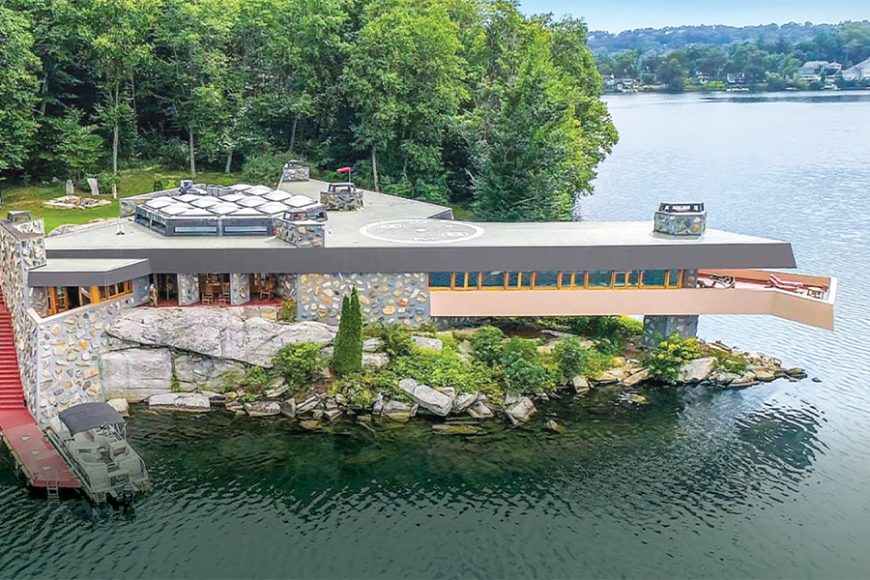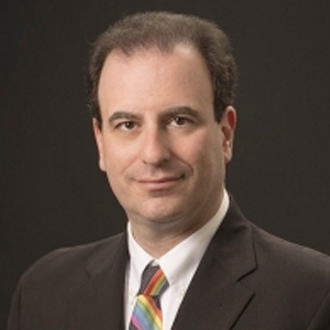Throughout his career, Frank Lloyd Wright challenged the limits of design and engineering. Many of his works were initially greeted with intense controversy due to his unorthodox approach to architectural aesthetics. But within Wright’s legendary canon is a property that generated controversy before construction began.
In 1949, Wright received a commission to design a house for Ahmed K. Chahroudi, an engineer who purchased Petra Island (also known as Petre Island), an 11-acre wooded oasis in the middle of Putnam County’s Lake Mahopac. Wright conceived a one-story, four-bedroom, 5,000-square-foot home based on a triangular grid that included a 25-foot cantilevered balcony that soared out over the lake. The latter design element recalled the famed terrace at Fallingwater, the rural Pennsylvania home that many consider to be Wright’s residential masterpiece. Chahroudi would later claim Wright envisioned this work to surpass his earlier achievement.
Wright created six drawings to illustrate his ideas initially, but Chahroudi balked when presented with a proposed $50,000 construction budget. Plans for the house were jettisoned and Wright circled back to design a 1,200-square-foot cottage for the island’s center. This modest structure became the Chahroudi family vacation home for many years.
In 1995, Joe Massaro, a sheet metal contractor, bought Petra Island and its cottage for $700,000. As part of the transaction, he received the drawings for the never-built Wright home. In 2000, Massaro sold his business to make the construction of the Wright home a full-time mission.
But there were challenges in Massaro’s path, not the least being an absence of Wright-crafted blueprints to serve as a guide for the project. He hired Thomas Heinz, an architect who worked on the renovation of several Wright structures, to fill in the missing aspects and introduce modern elements that were not available in Wright’s day, including air conditioning and radiant heating. Heinz used 3-D computer software to visualize Wright’s sketches at greater depth and kept all of the work in line with contemporary building codes.
But Massaro quickly ran afoul of the Frank Lloyd Wright Foundation, the nonprofit launched by the master architect in 1940 to preserve his legacy. The foundation claimed copyright ownership of the Wright sketches, while Massaro claimed the foundation demanded $450,000 to render working drawings from Wright’s sketches and to serve as the construction supervisor on the project. The parties went to court, with each claiming a victory: Massaro retained copyright ownership of the sketches, but the foundation forced Massaro to refer to his property as merely “inspired by Frank Lloyd Wright” and not being a bona fide Wright creation.
One aspect of the design that surprised Massaro was Wright’s fireplace fondness. The master architect was not content with a single living room cubbyhole for burning a few logs.
“Frank Lloyd Wright was big on fireplaces and we have six of them,” Massaro said in a 2007 interview with the trade journal Alternative Energy Retailer, “in the master bedroom, the library, the dining room, the living room, another bedroom and one outside on the deck that backs up to the living room and shares a chimney. The one in the living room is over 5 and ½ feet high and 8 feet wide.”
Oddly, Wright’s design had nothing regarding chimney caps. Rather than welcome the elements down the chimney, Massaro tapped Derek Lidstrom, owner of Chimney King in Gurnee, Illinois, to fill this void. Lidstrom began researching Wright’s houses to see what he used to cap chimneys, only to discover something strange.
“I went through about 120 Frank Lloyd Wright houses and blueprints and none of them had chimney caps,” he told Alternative Energy Retailer. “That was Wright’s eclectic style. He made his own rules.”
Obviously, those rules did not work on this project, and Lidstrom created custom-designed chimney caps for the property that encircle a rooftop helipad, another non-Wright feature.
The Frank Lloyd Wright Foundation would publicly complain about other changes to the Wright concept that strayed from his modus operandi. These included the decision to have the decorative “rubblestone” protrude from the wall rather than be flush with it and the use of domed skylights rather than the flat variety Wright preferred. Massaro claimed flat skylights have a tendency to leak. He also insisted he could not build Wright’s planned exterior stairway from the balcony due to code problems.
Nonetheless, what Massaro, Heinz and their construction team brought forth was visually dramatic, starting with the entry hall’s naturally occurring “whale rock” measuring 12 feet high and 60 feet long. The “tail end” of the rock is incorporated into the kitchen, which includes African mahogany woodwork custom-built to Wright’s specifications. Twenty-six triangular skylit windows offer brilliant natural illumination. Massaro commissioned Wright-designed furniture, including built-in pieces that further enhance the setting.
Massaro’s construction crew reportedly poured 150 tons of concrete for the floors and some of the walls to hold this creative vision in place. The total budget for the construction has never been made public.
While Massaro invited a PBS camera crew to record the construction’s completion in 2007 for a documentary, he never opened the house for the general public. Walter Cronkite was among the prominent guests invited for a private tour, and Massaro stated the veteran newsman commented, “I feel Frank in this house.”
Massaro and his family used the property as a residence until 2012, when he listed Petra Island, the house and the Chahroudi cottage for $19.9 million. But the listing attracted no serious inquiries. A 2013 rumor that Angelina Jolie and Brad Pitt were house hunting on Petra Island put the house back in the news, but potential buyers were not that starstruck.
The listing has been on-and-off the market for the past eight years, most recently in 2017 with a listing price of just under $15 million and then again in early 2019 for $12.9 million, where it remains today.
In an interview with the Los Angeles Times, Massaro acknowledged the criticisms he shouldered with his property but would not offer regrets.
“You hear these purists that talk about how no unbuilt Frank Lloyd Wright house should ever be built because Frank Lloyd Wright isn’t here anymore,” he said. “And then you take a look at this masterpiece of his. I’m sure Frank would rather have it built than not built at all.”


